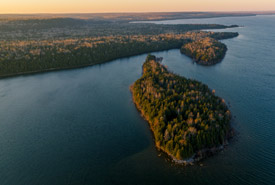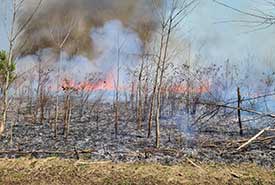NCC: Land Lines – 10 facts about fresh water in Canada

Vidal Bay, Manitoulin Island, ON (Photo by Striking Balance)
Fresh water may seem like a ubiquitous substance to some of us, especially if we live near an abundance of it in the form of lakes, rivers and streams. When I take a stroll to my neighbourhood greenspace that has a small tributary running through it, I often wonder whether I’ll find fish or other aquatic creatures living there, if I stare long enough. I wonder where this water flows to and from, and which body of water it’ll eventually empty into.
Perhaps fresh water seems so abundant to Canadians because Canada has the third-most renewable fresh water in the world and contains seven per cent of the world’s global supply of it. That’s a lot of fresh water! This is a precious and, for some parts of the world, scarce, life-supporting resource.
Freshwater ecosystems not only provide water for human consumption and industry, they are also vital for many species like fish, turtles, frogs, birds, beavers, insects and many more.
How many of these fresh water facts do you know?
- Although 70 per cent of the Earth is covered in water, only three per cent is fresh water. It is found in lakes, rivers, wetlands, glaciers and groundwater.
- 10 per cent of all known animals on Earth rely on freshwater ecosystems.
- The major source of fresh water is evaporation off the surface of the oceans; approximately 434,000 km3/year.
- Annually, Canada’s rivers discharge seven per cent of the world’s renewable water supply. Renewable fresh water is that which can be replenished by precipitation. Water is non-renewable when the source cannot be replenished, such as an underground reservoir.
- Almost nine per cent, or 891,163 square kilometres, of Canada’s total area is covered by fresh water.
- The Great Lakes Basin (shared with the United States) is the world’s largest freshwater lake system.
- Approximately 60 per cent of Canada’s fresh water drains to the north, while 85 per cent of the population lives along the southern border with the United States.
- The largest river basin in Canada is the Mackenzie Basin, based on drainage area and length.
- There are an estimated two million lakes in Canada, covering approximately eight per cent of Canada’s land area — more than any other country in the world.
- There are more than 8,500 named rivers in Canada.
Despite Canada’s relative abundance of fresh water, our freshwater ecosystems are at risk from degradation, fragmentation and contamination. The Nature Conservancy of Canada (NCC) has protected freshwater habitats across the country for the benefit of wildlife and people for close to 60 years. We are also restoring wetlands, forests and grasslands, which help filter and store water.
For example, NCC has recently protected Vidal Bay Forests and Shoreline, a 7,608-hectare area in Lake Huron on Manitoulin Island, the largest freshwater island in the world. This property’s alvars, forests, wetlands and grasslands store a large amount of carbon, help clean the air and store flood water. It is particularly critical for water quality and quantity and the protection of intact shoreline.
Led by the BC Wildlife Federation, the Wetland Workforce helps NCC assess wetland health on the West Coast. This team is actively restoring wetlands and shorelines with revegetation and invasive species removal, as well as shoreline clean ups.
NCC has also created the Freshwater Conservation Blueprint, a suite of five valuable tools to help assess the health of aquatic and riparian ecosystems of New Brunswick, PEI, Nova Scotia and southern Quebec. The goal is to help inform better land-use planning and watershed conservation across provincial and national borders.
These are just some examples in which NCC building on our conservation work and contributing to Canada’s target of protecting 30 per cent of our lands and waters by 2030. In coming years, we’re accelerating conservation to better conserve entire natural systems, and enhance connectedness between habitats, so nature can continue deliver essential services that support life on Earth.
Learn more about our work across the country >




